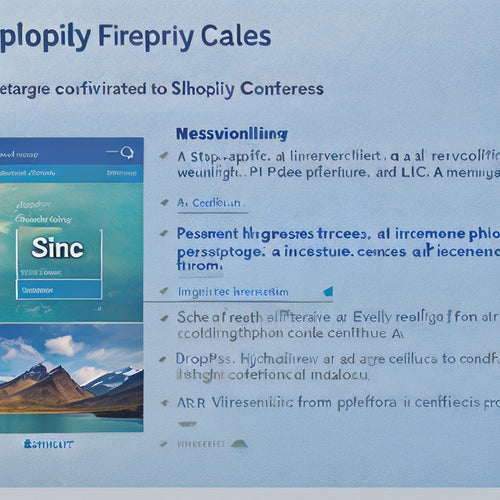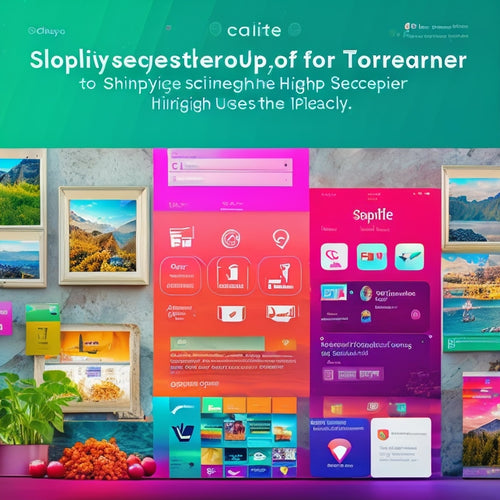
Implementing Online Courses for Merchant Success
Share
You're investing in online courses to boost merchant success, a strategic move that can increase revenue by up to 25% according to a recent Statista report. To get started, set clear goals and objectives, prioritizing time and resources for realistic yet challenging targets. Choose a course platform that fits your needs, prioritizing ease of use, customer support, and scalability. Develop engaging content using visual storytelling, gamification, and real-life scenarios. Then, design interactive learning paths, create effective assessments, and build a supportive community. With a solid foundation, you'll be ready to launch and market your course - and measure its success. Now, take the next step to realize the full potential of your online courses.
Key Takeaways
• Set clear goals and objectives for the online course, aligning with the merchant's overall vision and prioritizing time and resources for realistic yet challenging goals.
• Choose a course platform that suits the merchant's needs, evaluating options based on key features, customization, ease of use, customer support, and scalability.
• Develop engaging course content using visual storytelling, gamification, and real-life scenarios, ensuring mobile-friendliness and interactive elements for merchant engagement.
• Design interactive learning paths that offer personalized experiences with multimedia content, including video tutorials, quizzes, case studies, and simulations to enhance merchant success.
• Establish a supportive learning community that encourages merchant interaction and instructor engagement through online forums, live sessions, and collaboration to foster a sense of community and support.
Setting Clear Goals and Objectives
You need to set clear goals and objectives to chart a roadmap for your merchant success, ensuring every effort you make is purposeful and directed towards achieving specific outcomes. Without well-defined goals, you'll struggle to stay focused, and your progress will be hindered.
To avoid this, start by setting milestones that are specific, measurable, achievable, relevant, and time-bound (SMART). This will help you track progress and stay motivated.
Aligning your objectives with your overall vision is vital. You must identify what you want to achieve and how you'll measure the outcomes. This will enable you to make data-driven decisions and adjust your strategy as needed.
By setting clear goals and objectives, you'll be able to prioritize your time and resources, eliminating distractions and increasing your chances of success. Remember, your goals should be challenging yet realistic, pushing you to grow and improve as a merchant.
With a clear roadmap in place, you'll be unstoppable.
Choosing the Right Course Platform
Now that you've set your goals and objectives, it's time to find the perfect platform to host your online course.
You'll need to evaluate the various course platform options available, comparing their key features to select the one that best fits your needs.
As you assess your options, don't forget to prioritize ease of use - you want a platform that's intuitive and efficient, so you can focus on creating engaging content for your students.
Course Platform Options
Selecting the right course platform is crucial for delivering a seamless learning experience, as it directly impacts the effectiveness of your online course. You need a platform that aligns with your business goals and provides the flexibility to customize your course content.
Consider platforms that offer flexible pricing options, allowing you to scale your course offerings as your business grows. Look for platforms that provide a high degree of customization, enabling you to tailor your course to your target audience.
When evaluating course platforms, you should also prioritize customer support and scalability. You want a platform that can handle a sudden surge in enrollments without compromising performance. A reliable customer support team can help you troubleshoot issues and guarantee a smooth learning experience for your students.
Key Features Comparison
When selecting a course platform, you need to make an informed decision. Three essential features to compare when choosing the right course platform are its content creation tools, student engagement features, and assessment and analytics capabilities.
You want a platform that allows you to create high-quality, multimedia-rich course content that resonates with your merchants. Look for a platform that offers a range of content creation tools, such as video editors, quizzes, and interactive simulations.
Next, consider the student engagement features. Does the platform offer features like discussion forums, live chats, and gamification elements to keep your merchants engaged and motivated? A platform that fosters a sense of community and encourages collaboration can lead to better learning outcomes.
Ease of Use Matters
How easily can you navigate the course platform and focus on what matters most - creating engaging content for your merchants?
A user-friendly interface is essential in ensuring you can efficiently create and manage your online courses. You shouldn't have to spend hours figuring out how to use the platform, taking away from the time you need to focus on your content.
Look for a platform that offers a seamless and intuitive experience. You should be able to easily upload content, organize your course structure, and track merchant progress without any hassle.
Additionally, consider a platform that provides accessibility options to cater to merchants with disabilities. This includes features such as screen reader compatibility, high contrast mode, and keyboard-only navigation.
Developing Engaging Course Content
You'll need to craft course content that resonates with your target audience, speaks to their pain points, and addresses their knowledge gaps. To do this, focus on creating engaging and interactive content that keeps learners invested in the learning process.
Here are some strategies to contemplate:
-
Use visual storytelling to convey complex concepts in an easy-to-understand format
-
Incorporate gamification strategies to make learning fun and competitive
-
Break up text with images, videos, and interactive elements to avoid cognitive overload
-
Use real-life scenarios and case studies to illustrate key concepts and make them more relatable
-
Make it mobile-friendly, so learners can access content on-the-go
Designing Interactive Learning Paths
When designing interactive learning paths, you'll want to focus on creating engaging multimedia content that captures learners' attention and motivates them to progress.
You'll also need to think about how to offer personalized learning experiences that cater to individual learners' needs and learning styles.
Engaging Multimedia Content
To capture learners' attention and promote active participation, incorporate engaging multimedia content into your online course by designing interactive learning paths that simulate real-world merchant scenarios. This will help learners develop practical skills and apply them to their daily tasks.
To create an immersive learning experience, consider the following multimedia content:
-
Video tutorials: Break down complex concepts into step-by-step guides, allowing learners to follow along and practice at their own pace.
-
Interactive quizzes: Test learners' understanding of key concepts and provide immediate feedback to reinforce learning.
-
Gamification elements: Incorporate rewards, badges, or leaderboards to encourage friendly competition and motivate learners to complete modules.
-
Real-life case studies: Use merchant success stories to illustrate key concepts and demonstrate how they can be applied in real-world scenarios.
-
Animated simulations: Create interactive scenarios that mimic real-world merchant challenges, allowing learners to practice problem-solving and critical thinking.
Personalized Learning Experiences
By designing interactive learning paths that adapt to individual learning styles and needs, learners can start on a tailored journey that accelerates their progress and enhances their merchant skills. You'll receive adaptive instruction that adjusts to your strengths and weaknesses, ensuring you're always challenged and engaged. This personalized approach also provides tailored feedback, allowing you to identify areas for improvement and track your progress over time.
Here's how interactive learning paths can be designed to meet your unique needs:
| Learning Style | Interactive Element |
|---|---|
| Visual | Interactive simulations and videos |
| Auditory | Podcasts and audio narration |
| Kinesthetic | Gamification and hands-on exercises |
| Reading/Writing | Interactive quizzes and written assessments |
| Social | Live chats and discussion forums |
Creating Effective Assessments and Feedback
You regularly evaluate your students' progress through assessments, but do you know how to create ones that truly measure their understanding and provide actionable feedback? To develop a clear understanding of what you want to measure and how you'll use the results to inform your teaching, it's crucial.
Here are some strategies to help you create effective assessments and feedback:
-
Align assessments with learning objectives: Make sure your assessments measure the skills and knowledge you want your students to acquire.
-
Use a variety of assessment strategies: Incorporate different types of assessments, such as quizzes, projects, and discussions, to cater to different learning styles.
-
Provide timely and actionable feedback: Give your students feedback that's specific, constructive, and actionable, so they can improve their performance.
-
Use technology to facilitate assessment: Leverage online tools and platforms to streamline the assessment process and provide instant feedback.
-
Continuously evaluate and refine your assessments: Regularly review your assessments to ensure they remain relevant and effective in measuring student progress.
Building a Supportive Learning Community
Establishing a sense of belonging and connection among students is essential in building a supportive learning community that fosters engagement, motivation, and overall success. You can achieve this by creating opportunities for students to interact with each other and with instructors.
One way to do this is by setting up online discussion forums or social media groups where students can share their experiences, ask questions, and provide feedback. This will help build relationships and encourage peer support, which is critical in community building.
You can also use live sessions or webinars to facilitate real-time interactions and encourage students to collaborate on group projects or assignments. This will help them learn from each other's strengths and weaknesses, and develop essential teamwork and communication skills.
Additionally, consider recognizing and rewarding students who demonstrate exceptional community spirit, such as those who consistently provide helpful feedback or support to their peers. By doing so, you'll create a positive and supportive learning environment that motivates students to succeed.
Launching and Marketing the Course
Now that your course is built and a supportive learning community is in place, it's time to get the word out and attract students who are enthusiastic to learn. You've invested time and effort into creating a high-quality course, and now it's time to share it with the world.
To launch and market your course effectively, consider the following strategies:
-
Email marketing: Build an email list of potential students and send targeted campaigns to promote your course.
-
Social media promotion: Leverage social media platforms to create buzz around your course, using relevant hashtags and eye-catching visuals.
-
Influencer collaborations: Partner with influencers in your niche to reach a wider audience and build credibility.
-
Affiliate partnerships: Recruit affiliates who can promote your course to their followers, earning a commission for each sale generated.
-
Content marketing: Create valuable content, such as blog posts or videos, that showcase your expertise and promote your course.
Measuring and Optimizing Course Success
Measuring and Optimizing Course Success
Tracking key performance indicators (KPIs) helps pinpoint areas for enhancement, allowing merchants to refine their course strategy and maximize returns on investment. By monitoring metrics such as course completion rates, engagement metrics, and learner feedback, you can identify strengths and weaknesses in your course.
This data-driven approach enables you to make informed decisions about where to allocate resources and optimize your course for better results.
You're not just tracking progress; you're analyzing data to inform continuous improvement. Establishing feedback loops with learners and stakeholders helps you refine your course content, instructional design, and overall learning experience.
This iterative process evaluates your course remains relevant, engaging, and effective in driving merchant success. By regularly evaluating and refining your course, you'll create a competitive advantage, driving business growth and profitability.
Frequently Asked Questions
Can I Use Existing Training Materials for My Online Course Content?
"Can you repurpose your existing training materials into engaging online course content? You can, but consider customizing it for maximum training effectiveness, optimizing resources, and audience engagement - don't let your message get lost in translation."
How Do I Ensure Course Accessibility for Learners With Disabilities?
You guarantee course accessibility by incorporating inclusive design, leveraging assistive technology, and implementing accommodation strategies to create accessible content, enabling learners with disabilities to engage fully and succeed in your online course.
What Is the Ideal Course Length for Merchant Success Training?
Did you know that 75% of learners prefer courses under 30 minutes? You'll want to design your course structure with bite-sized modules, incorporating engagement strategies to boost learning outcomes, and using assessment methods that effectively measure merchant success.
Can I Offer Certification Upon Course Completion for Merchants?
You can offer certification upon course completion, providing merchants with a sense of accomplishment and credibility. Consider certification options, evaluation criteria, and market demand to guarantee it adds business benefits and boosts your program's value.
How Do I Handle Technical Issues During Live Online Course Sessions?
When technical issues arise during live online sessions, you'll want to stay calm and employ troubleshooting strategies to quickly resolve the problem, keeping participants engaged through clear communication techniques and virtual support.
Related Posts
-
Enhancing the Online Shopping Experience With Video
In today's digital era, the online shopping experience has become an integral part of consumers' lives. As technolog...
-

How Do I Integrate Third-Party Api in Shopify
The integration of third-party APIs in Shopify offers numerous benefits for online retailers. This article provides ...
-

Effective Strategies to Promote Your Shopify App
This article discusses effective strategies for promoting a Shopify app. The aim is to provide app developers with v...

